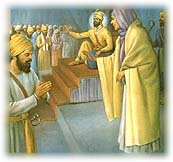 The "sadistic" gang must serve between 15 and 22 years |
Brent Martin, 23, who had learning difficulties, died in hospital after he was found in a pool of blood on Sunderland's Town End Farm estate.
William Hughes, 22, and Marcus Miller, 16, had admitted the murder but Stephen Bonallie, 17, had denied the charge.
The judge at Newcastle Crown Court ruled they must serve minimum terms of between 15 and 22 years.
Posed for photographs
The three, all trained boxers from Sunderland, repeatedly punched, kicked, stamped on and head-butted their victim over a £5 bet to see who could knock him out first.
They chased him around the Town End Farm estate just three months after he was released from a psychiatric hospital where he had been staying due to his learning difficulties, the court heard.

Finally he was stripped of his trousers and pants and left dying next to a parked car in Baxter Road, Town End Farm, as his attackers posed for photographs.
A post-mortem examination revealed Mr Martin died from a massive head injury and had suffered at least 18 separate blows to the head and neck.
Hughes, from Washington Road, must serve a minimum of 22 years, Bonallie, from Birtley Avenue, 18 years, and Miller, from Baxter Road, must serve at least 15.
Judge John Milford described the attack as "sadistic conduct on an extremely vulnerable victim".
![]()
![]() Brutally, cowardly - they acted like a pack of animals
Brutally, cowardly - they acted like a pack of animals ![]()
He said: "I would hope the minimum terms imposed upon young offenders are sufficiently long to spell out to young people the consequences of committing murder.
"If I am wrong, then perhaps the 12-year starting point for those under 18 needs to be looked at again by Parliament when the murder is, as in this case, particularly serious."
Judge Milford also said their victim has been a "gentle and caring person" who had a long history of mental health problems.
Ben Nolan QC, defending Miller, who has an IQ of 79, blamed the availability of cheap alcohol, and said litres of vodka were being sold for £6 in Sunderland.
"I calculate that to be 30p a double shot," he said.
'Effective action'
Outside the court, Mr Martin's family toasted the lengthy jail sentences with champagne and well-wishers wore white T-shirts displaying Mr Martin's name and picture.
His mother Brenda welcomed the sentence and praised the judge, adding: "The government needs to listen to murder victims' families."
Det Supt Barbara Franklin, who led the inquiry, also believed alcohol was a factor.

She said: "It's up to retailers to make sure it's sold responsibly, it's up to parents to take responsibility for what their children get up to outside the home.
"We need people to tell us when disorder is happening in their communities so we can take effective action before it gets out of hand.
"In the five years I've been a senior investigating officer this is one of the most brutal murders I've dealt with.
"Brutally, cowardly - they acted like a pack of animals. There's no other way to describe the people involved."
Ian Macrae, editor of Disability Now magazine, published by the disability charity Scope, said: "We are pleased that William Hughes, Marcus Miller and Stephen Bonallie have received such long sentences.
"But we are disappointed that the judge did not mention the fact that Mr Martin was clearly targeted because he was disabled and that his horrific murder was aggravated by hatred towards his impairment.
"Murders motivated by homophobia and racism often attract far stiffer sentences. All such horrific crimes must be treated equally by the criminal justice system."




































